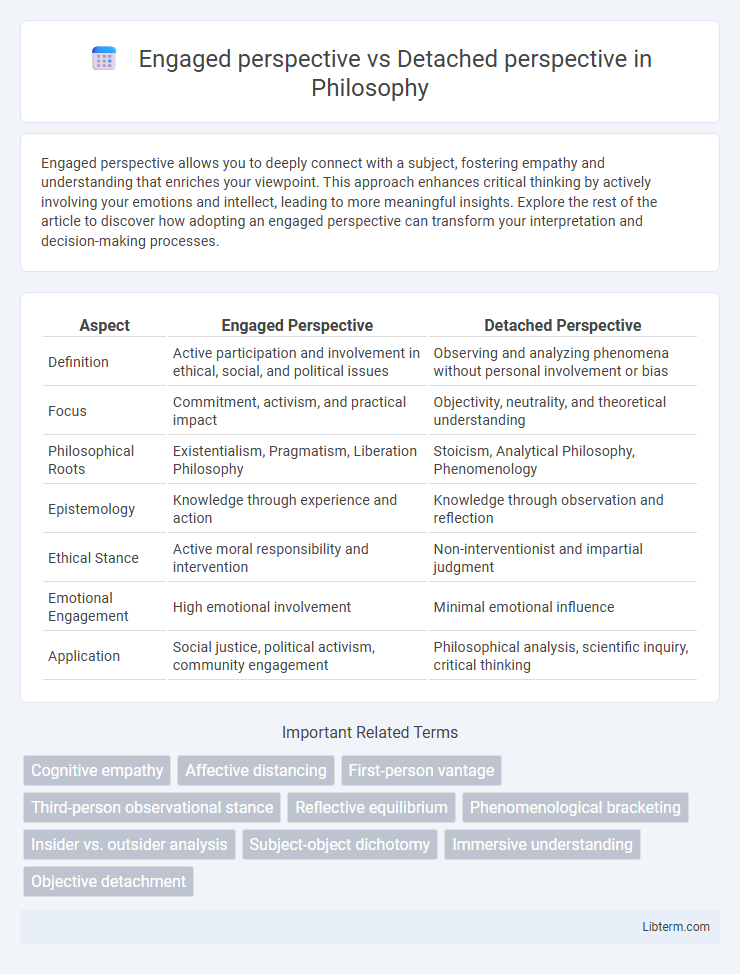Engaged perspective allows you to deeply connect with a subject, fostering empathy and understanding that enriches your viewpoint. This approach enhances critical thinking by actively involving your emotions and intellect, leading to more meaningful insights. Explore the rest of the article to discover how adopting an engaged perspective can transform your interpretation and decision-making processes.
Table of Comparison
| Aspect | Engaged Perspective | Detached Perspective |
|---|---|---|
| Definition | Active participation and involvement in ethical, social, and political issues | Observing and analyzing phenomena without personal involvement or bias |
| Focus | Commitment, activism, and practical impact | Objectivity, neutrality, and theoretical understanding |
| Philosophical Roots | Existentialism, Pragmatism, Liberation Philosophy | Stoicism, Analytical Philosophy, Phenomenology |
| Epistemology | Knowledge through experience and action | Knowledge through observation and reflection |
| Ethical Stance | Active moral responsibility and intervention | Non-interventionist and impartial judgment |
| Emotional Engagement | High emotional involvement | Minimal emotional influence |
| Application | Social justice, political activism, community engagement | Philosophical analysis, scientific inquiry, critical thinking |
Understanding Engaged and Detached Perspectives
Engaged perspective involves actively participating and empathizing with a situation, allowing for deeper emotional connection and insight. Detached perspective emphasizes observing events objectively without emotional involvement, promoting clarity and unbiased analysis. Understanding these perspectives helps balance emotional intelligence with critical thinking for informed decision-making.
Defining the Engaged Perspective
The engaged perspective involves active participation and emotional connection with subjects or situations, fostering deeper understanding through firsthand experience. It emphasizes empathy, involvement, and personal investment, allowing individuals to interpret events with nuanced insight. This approach contrasts sharply with detached perspectives, which maintain objectivity by minimizing personal bias and emotional influence.
Exploring the Detached Perspective
The detached perspective emphasizes objective observation by minimizing emotional involvement and personal bias, fostering clarity in complex decision-making processes. It allows individuals to analyze situations, such as conflict resolution or scientific research, with impartiality, ensuring logical evaluation based on facts and evidence. This approach enhances critical thinking and reduces cognitive distortions linked to subjective experiences.
Key Differences Between Engaged and Detached Views
Engaged perspective involves active emotional involvement and participation in a situation, emphasizing empathy and personal connection. Detached perspective prioritizes objectivity and emotional distance, allowing for unbiased analysis and critical thinking. Key differences include the level of emotional investment and the approach to decision-making, where engagement fosters empathy-driven responses and detachment supports rational evaluation.
Psychological Foundations of Each Perspective
Engaged perspective in psychology emphasizes active involvement, emotional connection, and immersion in experiences, facilitating empathy and deeper understanding of social interactions. Detached perspective promotes objective observation, reduced emotional bias, and critical analysis, enabling individuals to assess situations with clarity and maintain emotional regulation. Both perspectives are rooted in cognitive and affective processes that influence attention, interpretation, and emotional responses in various contexts.
Benefits of an Engaged Perspective
An engaged perspective enhances emotional intelligence by fostering empathy and deeper connections with others, leading to improved interpersonal relationships. This viewpoint promotes active involvement and mindfulness, which can increase motivation and overall life satisfaction. Research highlights that individuals with an engaged perspective experience better stress management and resilience compared to those with a detached perspective.
Advantages of a Detached Perspective
A detached perspective allows for unbiased decision-making by minimizing emotional involvement, leading to clearer and more rational judgments. It enhances objectivity in evaluating complex situations, promoting fair problem-solving and effective conflict resolution. By maintaining emotional distance, individuals can better analyze long-term consequences and strategic outcomes without distortion from personal biases.
Challenges and Limitations of Both Approaches
Engaged perspective often faces challenges such as emotional bias and reduced objectivity, which can hinder critical analysis in complex situations. Detached perspective struggles with limitations like lack of empathy and potential disconnection from real-world consequences, impairing meaningful understanding. Balancing emotional involvement with analytical distance remains a key difficulty for both approaches in achieving comprehensive insight.
Choosing the Right Perspective for Different Situations
Choosing the right perspective depends on the context and desired outcome; an engaged perspective fosters empathy and deeper connection in personal or collaborative settings, enhancing understanding and trust. In contrast, a detached perspective promotes objectivity and critical analysis, essential for decision-making in high-stakes or emotionally charged situations. Balancing both perspectives allows for adaptive responses, optimizing social interactions and problem-solving efficiency.
Integrating Engaged and Detached Perspectives for Better Outcomes
Integrating engaged and detached perspectives enhances decision-making by balancing empathy-driven insight with objective analysis. Engaged perspective fosters deep connection and understanding of context, while detached perspective enables critical evaluation free from emotional bias. Combining these viewpoints supports comprehensive problem-solving, leading to more nuanced and effective outcomes across personal and professional domains.
Engaged perspective Infographic

 libterm.com
libterm.com